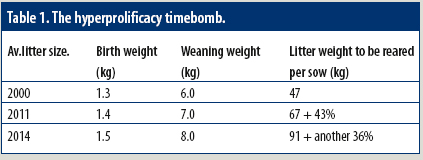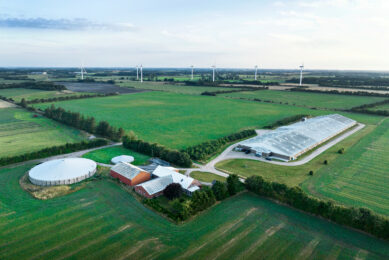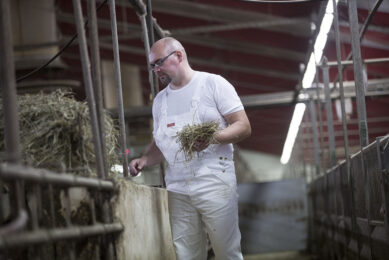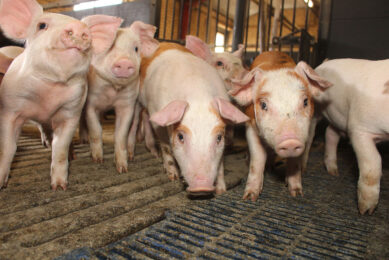Hyper prolificacy and the ‘Rescue Deck’

I have been talking to many commercial breeders across Europe since Christmas about the need to take the strain off the sow of suckling these very large litters of 14 and 15 piglets. While many of these farmers are struggling to achieve an average of 12, a typical response was: “It is all very well for top producers in Denmark, the Netherlands, France and the UK to claim such stratospheric results, but it will be a long time before it affects me!” Not so, dear reader – not so!
Three points to consider
First: The average producer is still not fully aware of the tremendous strides the top seed stock companies have made in raising litter size and the strain this puts on the female – especially gilts – to rear such large litters. Genetically the modern female produces the same amount of milk (4.25 g for each g of piglet gain) as she did 10 years ago when typical litter size was 10 to 11 at best. The modern gilt and sow just cannot eat enough of even an updated nutritionally-dense lactation diet to rear her much larger family. The litter not reaching its growth potential and/or the sow suffering – not so much from the ‘thin sow syndrome’ of the past, but what I call the `shattered sow syndrome’.
This is not the same, as it concerns the internal reproductive capability which is damaged, not so much flesh and fat-cover of the past, and this is not visibly apparent until too late.Second: While the pioneering advances have largely been made by the major breeding companies, I notice that many of the smaller firms are catching up fast. The ‘typical’ commercial breeder will soon be buying genetically built-in hyper prolificacy in any strain he favours, whether he likes it or not. So it will happen or is happening now anyway.
Third: The ‘typical’ breeder, who manages to survive current costs will, by process of economic elimination, be reasonably competent. Indeed I am noticing greatly improved stockmanship and management skills in gilt stimulation, improved service and post-service techniques on their farms. Good for you, your growing successes are adding to litter size and survivability, but at the same time are contributing to what I call the ‘hyper prolificacy kick-back’ of more second litter problems, rebreeding difficulties, higher piglet mortality and a shorter sow productive life (SPL).Table 1 is an attempt to show the recent-past, present and near-future situation and the impending mountain we have to climb with hyper prolificacy on our farms.
Forecast
By 2014 the nutrient demand on the sow and gilt approaches double since that of 2000. We are now at the tipping-point when the sow /gilt just cannot cope from nutrient intake alone.
Are rescue decks the solution?
It is one of the methods to keep more piglets alive, added to those of creep feeding (bought intelligently and fed properly), fostering (done correctly), nurse sows (chosen carefully) and so on. A rescue deck is a box fitted with heating and automated milk supply, and creep pre-starter later on, in the farrowing room in which surplus piglets which could normally die or be severely retarded can be successfully reared, turning non-viable pigs into profit.
Advantages of a rescue deck are:
• Considerably increase survival rates among starved or low birth weight pigs;
• Reduce the need for non-productive foster sows, nurse sows and expensive farrowing places, thus raising the farm’s farrowing rate;
• Solves essential welfare issues without the use of expensive medicines;
• Maintain good control of micro climate and hygiene;
• Designed for piglets that are three days old or older and have had the opportunity to drink adequate colostrum.
Good results
The results from many installations have been excellent. I refer to one 300-sow unit in the UK who rescue at least 60 pigs a month (See Pig World, July 2011 pps.28-29). Assuming current pig breeding performance in the top one-third of the British pig industry (representing10% higher productivity) I calculate a 2.4 pigs/sow/year greater productivity, or 17 kg per sow at weaning – all the more important as these at-risk piglets have already been paid for.
Econometrics
One deck, usually placed on high between two farrowing crates, should suffice the weaker/very small piglets from 10-12 sows over a three week usage period. Based on the above result the REO (Return on Extra Outlay) should be 1.85:1, not including the pipe run from the special milk mixer or installation of the decks, which will vary from farm to farm, and is at current UK prices, assuming an eight year amortisation life.
Quite a modest REO, but the AIV (Annual Investment Value) which reveals how hard your money is working for you, is particularly attractive at 11.5 (anything over four these days is good) as the equipment is ‘turned over’ many times in a year. So are all things to do with baby pigs compared to the finishing pig, for example. This AIV potential is important to counteract the first hesitant impressions of a potential user about initial equipment costs.











